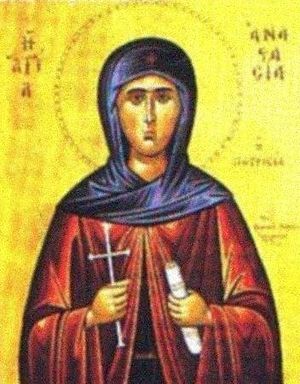Saint Anastasia the Patrician of Alexandria lived in Constantinople and was descended from an aristocratic family. She was an image of virtue, and she enjoyed the great esteem of the emperor Justinian (527-565). Widowed at a young age, Anastasia decided to leave the world and save her soul far from the bustle of the capital. She secretly left Constantinople and went to Alexandria. She founded a small monastery not far from the city, and devoted herself entirely to God.
Several years later, the emperor Justinian was widowed and decided to search for Anastasia and marry her. As soon as she learned of this, Saint Anastasia journeyed to a remote skete to ask Abba Daniel (March 18) for help.
In order to safeguard Anastasia, the Elder dressed her in a man’s monastic garb and called her the eunuch Anastasius. Having settled her in one of the very remote caves, the Elder gave her a Rule of prayer and ordered her never to leave the cave and to receive no one. Only one monk knew of this place. His obedience was to bring a small portion of bread and a pitcher of water to the cave once a week, leaving it at the entrance. The nun Anastasia dwelt in seclusion for twenty-eight years. Everyone believed that it was the eunuch Anastasius who lived in the cave.
The Lord revealed to her the day of her death. Having learned of her approaching death, she wrote several words for Abba Daniel on a potsherd and placed it at the entrance to the cave. The Elder came quickly and brought everything necessary for her burial. He found the holy ascetic still alive, and he confessed and communed her with the Holy Mysteries. At Abba Daniel’s request, Saint Anastasia blessed him and the monk accompanying him. With the words: “Lord, into Thy hands I commend my spirit,” the saint died in peace (ca. 567-568).
When the grave was prepared, the Elder gave his disciple his outer garment and ordered him to dress the deceased “brother” in it. As he was putting on the rassa, the monk noticed that she was a woman, but he did not dare to say anything. However, when they returned to the monastery after they buried the nun, the disciple asked Abba Daniel whether he knew the “brother” was a woman, and the Elder related to the young monk the life of Saint Anastasia. Later, the abba’s narrative was written down and received wide acclaim.
The relics of Saint Anastasia were transferred to Constantinople in the year 1200, and put not far from the church of Hagia Sophia.

